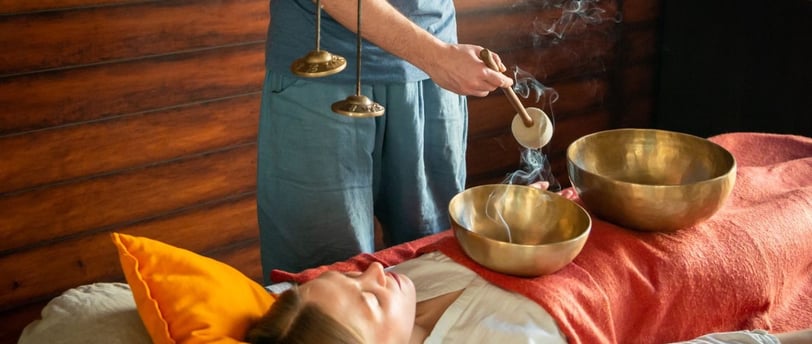Sound Therapy and Vibrational Healing: Using Music and Frequencies for Relaxation
Have you ever felt the soothing effect of your favorite song or noticed how a calming melody can shift your mood? Sound has an incredible ability to influence our emotions, energy, and overall well-being. This is the foundation of sound therapy and vibrational healing, practices that harness the power of music and frequencies to promote relaxation and healing. In this article, we’ll explore the science and techniques behind sound therapy, including sound baths, binaural beats, and chanting, and how these methods can enhance your physical, emotional, and spiritual health.


The Science of Sound and Vibrations
Sound is more than something we hear—it’s something we feel. Vibrations from sound waves interact with the body on a cellular level, influencing energy flow, brainwaves, and even physical health.
How Sound Therapy Works
Brainwave Entrainment: Different frequencies can align our brainwaves with desired states, such as relaxation or focus.
Resonance: The body’s cells and energy fields respond to sound frequencies, promoting balance and harmony.
Stress Reduction: Soothing sounds reduce cortisol levels and activate the parasympathetic nervous system, which is responsible for rest and recovery.
Sound Therapy Techniques
1. Sound Baths
Sound baths are immersive experiences where participants lie down and listen to resonant tones produced by instruments like:
Crystal Singing Bowls: Known for their pure, high-frequency tones.
Tibetan Bowls: Create deep, meditative vibrations.
Gongs: Produce a range of harmonics for deep relaxation.
Benefits of Sound Baths:
Promotes deep relaxation and stress relief.
Encourages emotional release and clarity.
Helps improve sleep quality and reduce anxiety.
2. Binaural Beats
Binaural beats involve playing two slightly different frequencies in each ear, creating a perceived “third tone” in the brain. This technique helps synchronize brainwaves to specific states:
Delta Waves (0.5–4 Hz): Deep sleep and relaxation.
Theta Waves (4–8 Hz): Creativity and meditation.
Alpha Waves (8–14 Hz): Calm focus and relaxation.
Beta Waves (14–30 Hz): Alertness and problem-solving.
How to Use Binaural Beats:
Listen with headphones for proper auditory separation.
Use tracks designed for specific outcomes, such as stress relief or focus.
3. Chanting and Vocal Toning
Chanting and vocal toning involve using the voice to produce sounds or mantras that resonate with the body. Examples include:
Om Chanting: The universal sound that represents creation and connection.
Mantras: Repeated sacred phrases, such as "Om Mani Padme Hum."
Humming or Toning: Simple sounds that align with the body’s natural vibrations.
Benefits of Chanting:
Enhances focus and mindfulness.
Stimulates the vagus nerve, which regulates stress responses.
Improves breathing and oxygenation.


Vibrational Healing and Frequency-Based Therapies
432 Hz and 528 Hz Frequencies
These are often referred to as "healing frequencies":
432 Hz: Believed to promote harmony and relaxation, aligning with the Earth’s natural vibrations.
528 Hz: Known as the “Love Frequency,” associated with DNA repair and emotional healing.
Tuning Fork Therapy
Tuning forks emit specific frequencies to target areas of tension or imbalance in the body. They are applied near chakras or energy centers to clear blockages.
Scientific Evidence Supporting Sound Therapy
Relaxation and Stress Relief:
A 2017 study in Journal of Evidence-Based Complementary & Alternative Medicine found that Tibetan singing bowls significantly reduced anxiety and tension.Improved Mental Clarity:
Research published in Frontiers in Human Neuroscience showed that binaural beats can improve focus and cognitive performance.Enhanced Sleep Quality:
A study in Global Advances in Health and Medicine demonstrated that sound baths improved sleep patterns and overall well-being in participants.
How to Incorporate Sound Therapy Into Your Routine
1. Attend a Sound Bath Session
Look for local practitioners offering sound baths or online experiences you can stream from home.
2. Create a Sound Therapy Space at Home
Invest in tools like crystal bowls, Tibetan bowls, or tuning forks.
Use a Bluetooth speaker for binaural beats or nature sounds.
3. Use Apps and Playlists
Apps like Insight Timer, Calm, and YouTube have guided sound therapy sessions tailored to specific needs like sleep, meditation, or stress relief.
4. Explore Chanting Practices
Incorporate chanting or humming into your meditation routine for an added vibrational benefit.
FAQs About Sound Therapy and Vibrational Healing
Q: Is sound therapy suitable for everyone?
A: Yes, most people can benefit from sound therapy. However, individuals with certain medical conditions, such as epilepsy, should consult a healthcare provider before using binaural beats.
Q: How often should I practice sound therapy?
A: Consistency is key. Even 10–15 minutes daily can yield noticeable benefits over time.
Q: Do I need special equipment for sound therapy?
A: Not necessarily. You can start with free binaural beat tracks or try simple vocal toning exercises.
The Bigger Picture: A Holistic Approach to Wellness
While sound therapy is a powerful tool, it works best as part of a balanced lifestyle. Combining it with practices like yoga, mindfulness, and healthy nutrition amplifies its effects, fostering a deeper sense of harmony and well-being.
Conclusion
Sound therapy and vibrational healing invite us to reconnect with an ancient, universal force: the power of sound. Whether through the resonant tones of a singing bowl, the subtle rhythm of binaural beats, or the transformative vibrations of chanting, these practices offer a pathway to relaxation, clarity, and healing.
Start small—attend a sound bath, hum a favorite tune, or play binaural beats while meditating. Let the vibrations guide you to a state of balance and serenity. After all, the power to heal and harmonize is as close as the next sound.
Products Reviews
Disclaimer
The statements on this website have not been evaluated by the Food and Drug Administration. The articles and products advertised are not intended to diagnose, treat, cure, or prevent any disease.
The content of the website and the products advertised are based on the opinions of the authors and are provided solely on an "AS IS" and "AS AVAILABLE" basis. You should do your own research and confirm information with other sources when seeking information about health issues, and always carefully review the information with your healthcare professional before using any of the protocols presented on this website and/or the products indicated. Neither Drops&Pills nor the authors are engaged in rendering medical or similar professional services or advice through this website or the products, and the information provided is not intended to replace medical advice offered by a physician or other licensed healthcare professional. You should not construe the recommendation of the products by Drops&Pills as an endorsement by Drops&Pills of the opinions expressed herein, or any guarantee of any strategy, recommendation, treatment, action, or application of advice made by the authors of the products.
Some names and personally identifiable information on this site have been changed to protect the privacy of individuals.
Drops&Pills is the publisher of the articles on this site. Drops&Pills' role as publisher does not constitute an endorsement, approval or review of the products advertised herein or any claim, statement or opinion used in the promotion of those products.
For product support, please contact the suppliers.
For purchase and order support, please contact the platform you placed the order through.
For support with article information, please contact Drops&Pills here.
*Free shipping according to the rules on the product page.
Natural Products for Better Health
© Drops&Pills Research 2025 All rights reserved
Contacts
contact@dropsandpills.com
